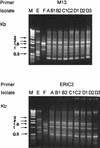Outbreak of Pseudomonas fluorescens bacteremia among oncology patients
- PMID: 9738043
- PMCID: PMC105087
- DOI: 10.1128/JCM.36.10.2914-2917.1998
Outbreak of Pseudomonas fluorescens bacteremia among oncology patients
Abstract
From 7 to 24 March 1997, four patients developed Pseudomonas fluorescens bacteremia at the hospital; one on the oncology ward and the other three in the chemotherapy room. These patients all had underlying malignancies and had the Port-A-Cath (Smiths Industries Medical Systems, Deltec, Inc., St. Paul, Minn.) implants. Three patients had primary bacteremia, and one had Port-A-Cath-related infection. None of these patients had received a blood transfusion before the episodes of bacteremia. All patients recovered: two received antimicrobial agents with in vitro activity against the isolates, and the other two did not have any antibiotic treatment. A total of eight blood isolates were recovered from these patients during the febrile episodes that occurred several minutes after the infusion of chemotherapeutic agents via the Port-A-Cath. These isolates were initially identified as P. fluorescens or Pseudomonas putida (four), Burkholderia (Ralstonia) pickettii (three), and a non-glucose-fermenting gram-negative bacillus (one) by routine biochemical methods and the Vitek GNI card. These isolates were later identified as P. fluorescens on the basis of the characteristic cellular fatty acid chromatogram and the results of supplemental biochemical tests. The identification of identical antibiotypes by the E test and the random amplified polymorphic DNA patterns generated by arbitrarily primed PCR of the isolates showed that the outbreak was caused by a single clone of P. fluorescens. Surveillance cultures of the possibly contaminated infusion fluids and disinfectants, which were performed 7 days after recognition of the last infected patient, failed to isolate P. fluorescens. This report of a small outbreak caused by P. fluorescens suggests that timely, accurate identification of unusual nosocomial pathogens is crucial for early initiation of an epidemiological investigation and timely control of an outbreak.
Figures


Similar articles
-
Multistate outbreak of Pseudomonas fluorescens bloodstream infection after exposure to contaminated heparinized saline flush prepared by a compounding pharmacy.Clin Infect Dis. 2008 Dec 1;47(11):1372-9. doi: 10.1086/592968. Clin Infect Dis. 2008. PMID: 18937575
-
Epidemiological investigation of Pseudomonas aeruginosa nosocomial bacteraemia isolates by PCR-based DNA fingerprinting analysis.J Med Microbiol. 1996 Nov;45(5):359-65. doi: 10.1099/00222615-45-5-359. J Med Microbiol. 1996. PMID: 8918952
-
Nosocomial pseudoepidemic caused by Bacillus cereus traced to contaminated ethyl alcohol from a liquor factory.J Clin Microbiol. 1999 Jul;37(7):2280-4. doi: 10.1128/JCM.37.7.2280-2284.1999. J Clin Microbiol. 1999. PMID: 10364598 Free PMC article.
-
Pseudomonas putida bacteremia in adult patients: five case reports and a review of the literature.J Infect Chemother. 2011 Apr;17(2):278-82. doi: 10.1007/s10156-010-0114-0. Epub 2010 Sep 1. J Infect Chemother. 2011. PMID: 20809240 Review.
-
Brevundimonas spp: Emerging global opportunistic pathogens.Virulence. 2018 Jan 1;9(1):480-493. doi: 10.1080/21505594.2017.1419116. Virulence. 2018. PMID: 29484917 Free PMC article. Review.
Cited by
-
Multiple antibiotic-resistant bacteria on fluted pumpkin leaves, a herb of therapeutic value.J Health Popul Nutr. 2014 Jun;32(2):176-82. J Health Popul Nutr. 2014. PMID: 25076655 Free PMC article.
-
Health implications associated with exposure to farmed and wild sea turtles.JRSM Short Rep. 2013 Jan;4(1):8. doi: 10.1177/2042533313475574. Epub 2013 Jan 29. JRSM Short Rep. 2013. PMID: 23413410 Free PMC article.
-
DGGE Identification of Microorganisms Associated with Borrelia burgdorferi Sensu Lato- or Anaplasma phagocytophilum-Infected Ixodes ricinus Ticks from Northwest Norway.Int J Microbiol. 2013;2013:805456. doi: 10.1155/2013/805456. Epub 2013 Oct 27. Int J Microbiol. 2013. PMID: 24282414 Free PMC article.
-
Type III secretion system and virulence markers highlight similarities and differences between human- and plant-associated pseudomonads related to Pseudomonas fluorescens and P. putida.Appl Environ Microbiol. 2015 Apr;81(7):2579-90. doi: 10.1128/AEM.04160-14. Epub 2015 Jan 30. Appl Environ Microbiol. 2015. PMID: 25636837 Free PMC article.
-
Pseudomonas fluorescens Complex and Its Intrinsic, Adaptive, and Acquired Antimicrobial Resistance Mechanisms in Pristine and Human-Impacted Sites.Antibiotics (Basel). 2022 Jul 22;11(8):985. doi: 10.3390/antibiotics11080985. Antibiotics (Basel). 2022. PMID: 35892375 Free PMC article. Review.
References
-
- Gilligan P H. Pseudomonas and Burkholderia. In: Murray P R, Baron E J, Pfaller M A, Tenover F C, Yolken R H, editors. Manual of clinical microbiology. 6th ed. Washington, D.C: American Society for Microbiology; 1995. pp. 509–519.
-
- Hsueh P R, Teng L J, Lee P I, Yang P C, Huang L M, Chang S C, Lee C Y, Luh K T. Outbreak of scarlet fever at a hospital day care centre: analysis of strain relatedness with phenotypic and genotypic characteristics. J Hosp Infect. 1997;36:191–200. - PubMed
MeSH terms
Substances
LinkOut - more resources
Full Text Sources
Other Literature Sources

